As an Oakville Painter I often get questions around surface prep and all the great things we can do before we actually open up a can of paint and put the brush to the wall. Here is my list of 10 critical things you want to do before you start painting.
- Empty as much as you can out of room. Working around clutter is no fun and a sure way to spill paint. All furniture that can be reasonably removed from the room should be. Moving the furniture to the center of the room is ideal. Try to maintain a 3 to 4 foot clearance around the parameter of the room, this will give you the best results when rolling the walls and allow you to use a small extension pole (which will give you more leverage and make the overall job of painting easier).
- Put down lots of drop sheets can and cover all furniture. Rollers create over spray – it usually comes off with a little water – as a professional contractor
I have wastedI have seen painters waste hours cleaning up when they just could have spent 15 minutes putting down drop sheets.
- Fill all cracks between the wall and the baseboards with latex caulk – this will create a solid and professional look. You can’t sand dry caulking (sorry Joe) so its the finish product once you leave it.
- Scuff sand all walls with 150 grit sand paper – scuff sanding removes all the specks and lint from the previous paint job. As well, scuff sanding will provide for better surface adhesion which is important if you’re going from a eggshell to flat or low luster finish.
- If your paint the baseboard and window frames these are best sanded using a sponge sander as it can work into the curves of the molding. Extra effort spent sanding the the base of door frames and the baseboards with a sponge will reward the painter with a very professional paint finish.
- Fill all holes and cracks. Remember filling larger wholes will take three applications of plaster to create a proper (new like) finish. When filling holes take a tool (eg a screwdriver) with a round ended handle – using the round end of the tool press into the wall where the hole is – this should create a small divot around where the hole was – this will be much easy to fill than simple hole in the wall (the plaster will adhere better and sanding will be easier).
- Prime all areas where plaster has been applied – if you don’t the paint will shadow where the plaster patch was applied – to remedy this apply one additional coat (if the paint is self-priming) or just use primer (like the pros do).
- Use tape if you’re not a pro – it will save you time and create a beautiful straight cut line, see my blog entry on tips for using Painters Tape.

- If the previous painter made a mess of the ceiling cut line and you don’t want to paint the ceiling again purchase a quart of good ceiling paint and skirt the parameter of the ceiling with it to cover the bad cut lines. Really only apply enough paint on the ceiling to cover the bad cut line, most of the ceiling paint you apply should be on the wall with only a very small line on the ceiling – eg a quarter of an inch.
- Clean and dust the room completed but do it just before you paint. Surface prep creates a lot of dust and that dust must be removed prior to painting. Clean above and door window frames as these are common places for unseen dust to collect. Dust collected by the brush during the application of the finish coat will leave the brush somewhere you just don’t want it to – like around a face plate or a window frame cut line right at eye level.
As a professional painter in Oakville I have always said that the key to any good painting review is the prep work. When hiring your next painter for your Oakville painting project make sure both of you have common expectations on the level of prep work required. My experience has shown me that this can be the biggest disconnect between what the customer thought they were getting and what they actually got. Be sure to point out to the painter examples of holes and dents you expect to be filled so that your painter knows what you expect when the job is completed.
Oakville, Ontario
L6M 1X3
CA
Phone: (905) 334-3242
Website: www.sharrardpainting.ca




Great surface preparation tips! You have given nice tips which can helps a lot for a perfect interior painting and i will definitely follow them while painting interior of my house.